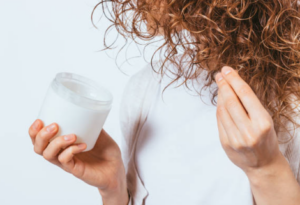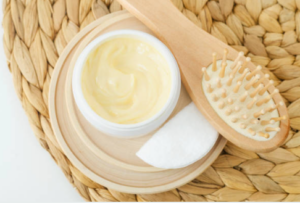Whip Up Wonder Locks

Have you ever dreamt of cascading curls, a mane of vibrant shine, or simply healthy, manageable hair? We all crave luscious locks, but navigating the world of hair products can be daunting. Store-bought options are often packed with chemicals, silicones, and sometimes even hidden animal derivatives. But fear not, eco-conscious beauties and hair enthusiasts! This guide delves into the world of DIY vegan hair butters, offering a haven of natural ingredients, personalized customization, and the freedom to craft the perfect solution for your unique hair type.
Unveiling the Benefits of Vegan Hair Butters
Vegan hair butters go far beyond simply avoiding animal-based ingredients. They prioritize natural, plant-based powerhouses packed with vitamins, fatty acids, and moisture-rich properties. These butters nourish your hair from root to tip, promoting elasticity, shine, and manageability. Shea butter, for example, is a superstar ingredient for dry hair, offering deep hydration and taming frizz. Additionally, the DIY approach allows you to control the quality of ingredients, ensuring exactly what goes onto your precious strands. This empowers you to create a hair butter that caters to your specific needs and sensitivities, unlike some store-bought products that might contain undisclosed ingredients.
However, it’s important to acknowledge potential trade-offs. While vegan butters often prioritize gentle ingredients, some, like shea butter, can be thick and heavy. This might not be ideal for fine hair, as it can weigh down the strands. Remember, there’s a perfect balance to be achieved! Experimentation is key to finding the right combination of ingredients for your hair type.
Decoding the Ingredients
Now, let’s explore the science behind some popular vegan hair butter ingredients and the potential challenges associated with each:
- Shea Butter: A superstar for dry hair, shea butter offers deep hydration and helps tame frizz. Rich in vitamins A and E, it also promotes a healthy scalp. Challenge: Shea butter can be thick and heavy, so it might not be ideal for fine hair.
- Cocoa Butter: This luxurious butter adds shine and manageability while offering UV protection for your hair. Challenge: Cocoa butter can also be heavy and might weigh down fine hair.
- Mango Butter: Lightweight and easily absorbed, mango butter provides deep conditioning without weighing down fine hair. Challenge: Mango butter might not offer the same level of intense moisture as shea butter for very dry hair.
- Coconut Oil: Antibacterial and antifungal properties make coconut oil a great choice for scalp health. It also adds shine and promotes hair growth. Challenge: Coconut oil can build up on hair over time, so it’s important to clarify occasionally to prevent greasy buildup.
- Carrier Oils: These versatile oils, like jojoba oil and grapeseed oil, act as a base for your butter, dilute the potency of other ingredients, and add additional nourishing properties. Choosing the right carrier oil depends on your hair type. For example, grapeseed oil is lightweight and good for fine hair, while jojoba oil is more moisturizing for dry hair.
- Essential Oils: Aromatic powerhouses, essential oils like lavender and rosemary can add a delightful scent while offering scalp-soothing and hair-stimulating benefits. Challenge: Essential oils can be very potent, so use them sparingly and always dilute them properly with carrier oil to avoid irritation.
DIY Hair Butters for Every Strand
Now that you’re familiar with the key ingredients, let’s get mixing! Here are some basic DIY vegan hair butter recipes to get you started, keeping the potential challenges in mind:
- For Dry Hair: Combine equal parts shea butter, cocoa butter, and mango butter. Add a tablespoon of carrier oil (like jojoba oil) and a few drops of your favorite essential oil (optional). This recipe offers deep hydration and frizz control, but remember to adjust the shea butter amount if you have fine hair.
- For Fine Hair: Opt for a lighter butter by using more mango butter and carrier oil (like grapeseed oil) than shea butter. Skip the cocoa butter to avoid weighing down your strands. This recipe provides moisture without weighing down fine hair.
- For Scalp Soothing: Combine shea butter with carrier oil (like jojoba oil) and add a few drops of calming lavender essential oil. This recipe focuses on scalp health and can help soothe irritation, but if you have oily hair, it might make your scalp feel greasy. Consider using a lighter carrier oil like grapeseed oil in this case.
Remember: These are just starting points! Experiment with different ingredient ratios and essential oils to create a customized hair butter that caters to your specific needs and hair type.
Mastering the Art of DIY Hair Butters
Crafting your own DIY vegan hair butter is a rewarding experience. It empowers you to personalize your hair care routine, embrace natural ingredients, and avoid harsh chemicals or undisclosed animal derivatives. But venturing into the world of DIY requires a few key steps:
- Gather Your Tools: You’ll need basic kitchen equipment like a heat-resistant bowl, a whisk, a double boiler (or a saucepan and a smaller bowl that fits snugly on top), and measuring spoons.
- Source High-Quality Ingredients: Opt for organic, cold-pressed butters and carrier oils whenever possible. This ensures you’re getting the purest form of these ingredients with maximum benefits for your hair.
- Safety First: Always perform a patch test on your inner arm before applying any new DIY hair product to your scalp or hair. This helps identify any potential allergies or sensitivities to specific ingredients.
Tips and Techniques
Here are some additional tips and techniques to elevate your DIY hair butter experience:
- Melting Magic: The double boiler method is the safest way to melt your butters. Fill the bottom saucepan with water and bring it to a simmer. Place the heat-resistant bowl containing your butters on top, ensuring it doesn’t touch the simmering water. This indirect heat prevents scorching and ensures even melting.
- Whipping Up Perfection: Once your butters are melted and cooled slightly, use a hand mixer to whip the mixture until it reaches a light and fluffy consistency. This incorporates air into the butter, making it easier to spread and absorb into your hair.
- Essential Oil Etiquette: Remember, a little goes a long way with essential oils. Start with just a few drops and gradually add more until you achieve your desired scent. Always dilute them properly with carrier oil to avoid irritation.
- Storage Solutions: Store your finished hair butter in an airtight container in a cool, dry place. This helps maintain its consistency and prevents spoilage. Generally, homemade hair butters have a shelf life of 3-6 months.
Cultivating Healthy Hair Habits
A nurturing hair butter is a fantastic tool, but a holistic approach is key to healthy hair:
- Gentle Cleansing: Avoid harsh shampoos that strip your hair of natural oils. Consider using a co-wash or a gentle, sulfate-free shampoo that cleanses without being overly drying.
- Deep Conditioning: Regularly treat your hair to a deep conditioning treatment with your DIY hair butter or a natural hair mask. This helps replenish moisture and promote overall hair health.
- Diet for Shine: Nourish your hair from the inside out by maintaining a balanced diet rich in essential vitamins and minerals. Biotin, vitamin E, and Omega-3 fatty acids are all important for healthy hair growth and shine.
- Hydration Hero: Drinking plenty of water is crucial for overall health, and it also benefits your hair. Adequate hydration helps keep your scalp healthy and prevents dryness.
By incorporating these practices alongside your DIY vegan hair butter routine, you can cultivate healthy, radiant hair that thrives naturally.

Frequently Asked Questions
Here are some frequently asked questions to address any lingering concerns you might have about DIY vegan hair butters:
- Can vegan hair butters be effective for all hair types? Vegan hair butters offer a wide range of benefits, but the key lies in choosing the right ingredients for your specific hair type. Experiment with different recipes and ratios to find the perfect combination for your needs.
- What if I have allergies? As with any new product, it’s crucial to perform a patch test before applying the hair butter to your scalp or hair. Additionally, research the ingredients carefully and avoid any known allergens.
- How often should I use a hair butter? Hair butter frequency depends on your hair type and climate. Generally, for dry hair, you can use it 2-3 times a week, while for normal hair, once or twice a week might suffice.
Embrace the world of DIY vegan hair butters, and embark on a journey of natural hair care! With a little experimentation, these homemade concoctions can be a game-changer for your hair’s health and beauty. So, unleash your inner alchemist, whip up a batch of your personalized hair butter, and flaunt those luscious locks with confidence!

